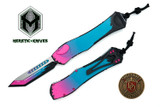Precision Edge Craft: Knife Sharpening
Precision Edge Craft: Mastering Knife Angles for Optimal Performance
In the realm of cooking, sharp knives reign supreme. The significance of maintaining razor-sharp edges goes beyond mere convenience; it's a matter of safety.
Dull blades in the kitchen are an invitation to accidents. They force you to apply extra force while cutting, enhancing the risk of slippage and mishaps. Worse yet, the use of blunt knives often leads to squashed ingredients instead of clean cuts, drastically altering both the texture and taste of your culinary creations. Let's embark on a journey to uncover the enigma behind maintaining the keenness of your blades.
Central to the art of sharpness is the angle at which your knife's edge is honed. The intricacy of this angle selection is grounded in the nature of your knife.
A myriad of knives, each designed for specific tasks, necessitates a tailored approach to angles:
6-Degree Finesse: Precision personified, ideal for slicing through delicate entities like tomatoes and citrus fruits. The filet knife is a prime example.
8-Degree Mastery: Elegance meets sharpness, a choice for those slicing through tender vegetables and fish. Embraced by the Santoku and Nakiri knives.
10-Degree Equilibrium: Where sharpness meets durability, a sweet spot for all-purpose blades like chef's knives and utilities.
13-Degree Precision: A notch above 20 degrees, an ideal pick for fish filleting and meat slicing. Exhibit A: the slicing and boning knives.
15-Degree Finesse: An extra dimension of sharpness for soft ingredients like vegetables and fish. The Santoku and Nakiri knives nod in agreement.
20-Degree Balance: Striking equilibrium between sharpness and ruggedness, a staple for versatile tasks like chopping and slicing.
25-Degree Strength: A robust angle for tackling tough challenges, be it meats or bones. Carving and butcher knives exemplify this power.
Now, the journey to discovering your knife's optimal angle isn't complete without acknowledging the steel's personality. Different types of steel call for different angle considerations.
Take, for instance, the contrast between high-carbon steel's demands and those of stainless steel. The former thrives at steeper angles, while the latter necessitates a more subtle approach.
Prior to embarking on your sharpening quest, decipher your knife's composition to make the right angle choice.
With the key to blade sharpness in hand, you're poised to select the perfect angle for your knife, thrusting you into the realm of professional-level sharpening.
Remember, gentleness and angle consistency are your allies. With practice, you'll wield a blade that effortlessly breezes through any culinary challenge. So, armed with the knowledge of your knife's ideal angle, gather your whetstones and embark on the sharpening odyssey!
To perfect the edge at a 6-degree angle, opt for a sharpening stone with a silky 8000 grit. The ritual begins by moistening the stone and securing it on a non-slip surface. Maintain a steadfast 6-degree angle while gliding the knife along the stone, applying gentle pressure. Repeat on the opposite side until sharpness is achieved.
For an 8-degree edge, the journey calls for a 3000-grit sharpening stone. Wet the stone, secure it, and gracefully move the knife at an 8-degree angle, letting delicate pressure prevail. Repeat for the other side until sharpness prevails.
The 10-degree realm requires a 1000-grit stone. Following the moistening and securing protocol, sustain a 10-degree angle as the knife gracefully traverses the stone. Complete the process on the opposite side until sharpness graces the blade.
Venturing into the 13-degree domain calls for a 3000-grit stone. A wet, secure stone sets the stage. Glide the blade at a composed 13-degree angle, applying the lightest touch. Mirror the process for the reverse side to claim sharpness.
The 20-degree realm necessitates a coarser 400-grit stone. Wet, secure, and begin the journey at a 20-degree angle. Gentle pressure and consistent movement will be your allies. Transition to the opposite side for uniform sharpness.
For the 25-degree threshold, a robust 500-grit stone is your companion. Wet the stone, secure it steadfastly, and execute a 25-degree angle with the blade's journey along the stone.
Duplicate the process on the opposing side until the blade proudly exudes sharpness.
Recent Posts
-
Hidden Lives in Steel: The Prone Grinders of Thiers (and Their Dogs)
In the early 1900s, amid the steep hills and flowing Durolle waters of Thiers, France, blade prod …Oct 6th 2025 -
The Heretic Hydra V4 OTF: A Bold New Miami Vice Edition
Few knives capture the imagination of collectors like the Heretic Hydra series. For years, the Hydra …Aug 28th 2025 -
Precision Edge Craft: Knife Sharpening
Precision Edge Craft: Mastering Knife Angles for Optimal PerformanceIn the realm of cooking, sharp k …Nov 13th 2023

